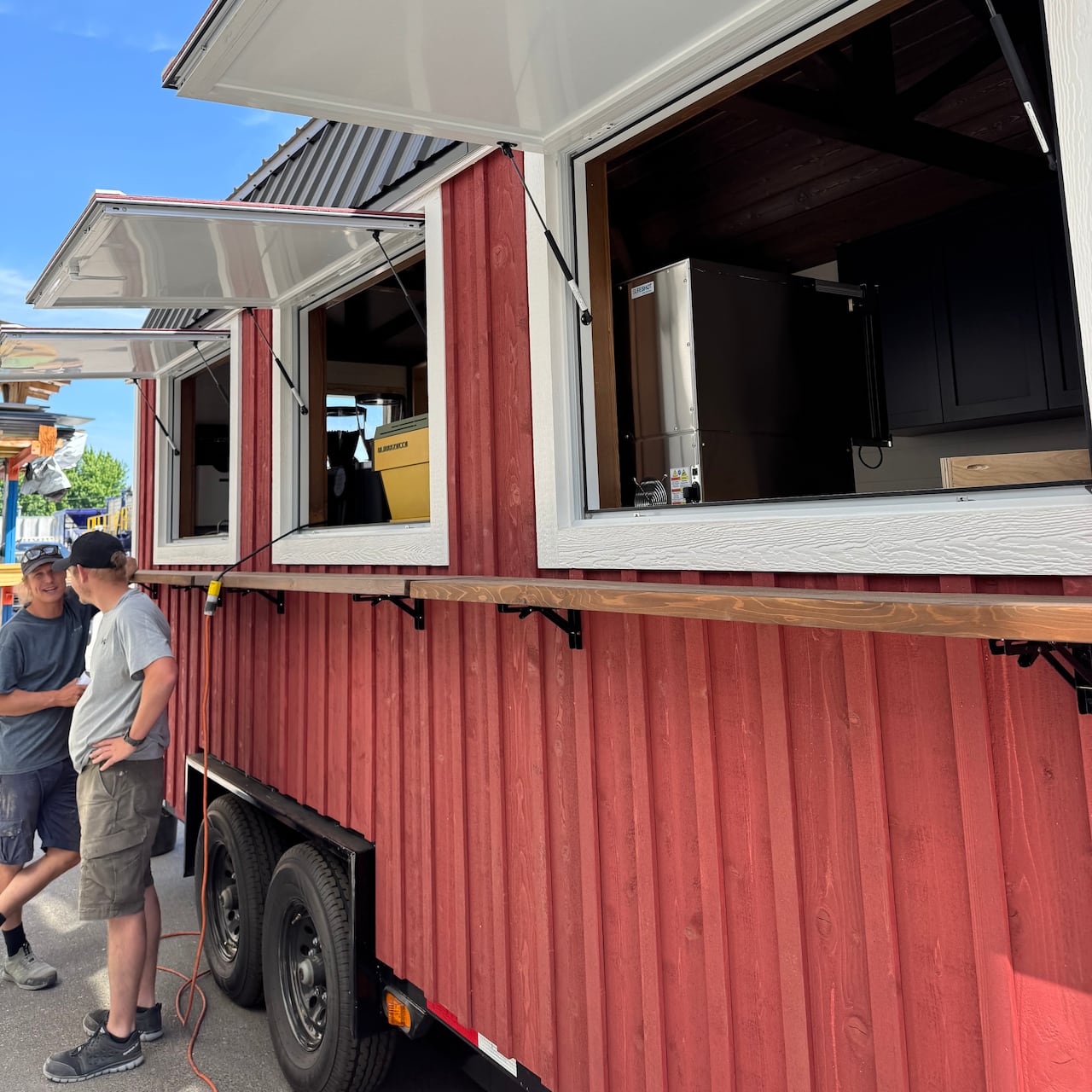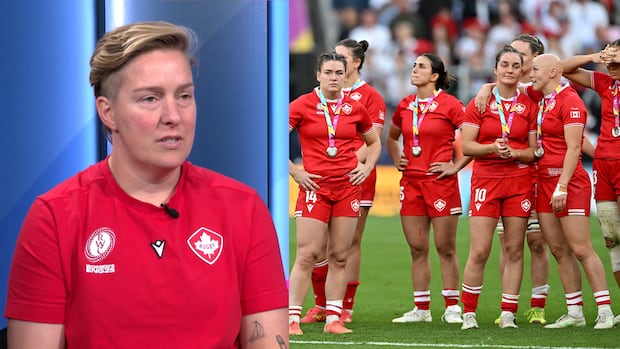Caitlin Nash’s cappuccino skills, by her own admission, could use some work.
“It’s actually shockingly hard. But we’re getting there,” the Canadian luger, who is doubling as a barista as she aims to compete in her first Olympics at Milano Cortina 2026, told CBC Sports.
Nash is among Canada’s bright young Olympic stars. Looking to peak in time for 2030, a spot in Milan would give Nash the requisite experience needed to refine her approach and reach the podium four years later.
But, for now, she’s distracted by the task at hand — getting the milk to the exact right consistency for each espresso-based drink she’s learning to make.
In addition to being a full-time athlete, Nash is a part-time barista at Hayloft, a mobile coffee service created by speed skater Hayden Mayeur after he lost his job at Calgary’s Olympic Oval during the pandemic.
Mayeur responded by buying a coffee truck.
More specifically, the Toronto native purchased an antique Citroen car, which he remodelled into a mobile espresso service over the course of a year.
Now, Hayloft claims customers in the energy sector, real estate, golf courses and more.
Business became successful for Mayeur
The business became so successful that Mayeur needed to bring on some baristas. He turned to fellow speed skaters, bobsledders, lugers, and others.
“We’ve kind of now created a platform where athletes who can’t necessarily afford to have a full-time, part-time job working at the mall or whatnot, but still need the extra cash to make ends meet, they can pick up shifts with Hayloft around their training schedules,” Mayeur revealed to CBC Sports.
Indeed, the Canadian sport system is strained financially at all levels. Athletes bear much of the burden, however, as costs are passed down. Being an Olympian, these days, is at once more of a full-time commitment and less sustainable than ever.
Hayloft is one potential solution for the crisis.
As the pandemic subsided, Mayeur returned to his job at the Oval. When he left a second time, it was of his own accord.
“The first year that I was able to leave my part-time job at the Olympic Oval, because Hayloft was doing well enough, I won my first world-championship medal. So I would say there’s a direct correlation. Like, yes, I’m busy, but I’m busy on my own schedule,” said Mayeur, who at 28 seeks his first Olympic appearance.
Mayeur described Hayloft as “Team Canada owned and operated.” He has a roster of multiple fellow athletes, all based in Calgary, to whom he offers shifts, with wages starting at $30 per hour, according to Mayeur.
The athlete-employees then choose times that work for them around their training schedules. In theory, they would no longer have to work the type of blue-collar gig Mayeur worked for so long, the kind often kept him up late and disrupted his job as an athlete.
“Whatever we can spare, just, that’s the whole point of what I’ve built is to be able to support other athletes right now. And that’s super important. So if that’s putting a smile on their faces and if that’s allowing them to focus on their goals, sick, because that’s what it’s done for me,” he said.

‘Such a big relief’
Nash said she was grateful for the opportunity.
“Hayden being an athlete and having been in a position before where he was sort of struggling to make his work schedule and his athletic schedule work together, he gets that and I’m so grateful for it. It’s been such a big relief,” she said.
Athletes and their NSOs have gotten creative in other ways, too. The national women’s rugby team partnered with the iconic rock band The Tragically Hip to sell T-shirts with proceeds going toward supporting its World Cup journey, where it won silver. In fact, Rugby Canada announced Thursday its “Mission: Win Rugby World Cup 2025” fundraising campaign exceeded its goal, bringing in just over $1 million.
Summer McIntosh is believed to be the first individual athlete with a jersey sponsor. Bobsledder Cesar De Guzman and some teammates are trying to go viral on social media with their “Feed a bobsledder” series.
“We did the exact same thing when I was an athlete,” said secretary of state for sport and Olympic sprint kayak champion Adam van Koeverden. “You go out and you ask for some support. There’s no shame in asking for help when you’re an athlete, particularly a Canadian amateur athlete.”
Canadian rugby players Tyson Beukeboom and Taylor Perry were treated like rock stars at the Women’s Rugby World Cup in England, where they captured a silver medal. But without full-time contracts or a domestic league back home, they are both unemployed and looking for work.
But while Hayloft appears to be an innovative band-aid on the financial crisis — and Mayeur said he wants to expand to other athlete training hubs across Canada — the idea would be to simply allow athletes to be athletes.
“If you were to pool all the top [speed-skating] countries in the world, I would probably feel pretty good telling you that we are likely at the bottom of the pool for funding out of that group,” Mayeur said.
“Through conversations that I’ve had with athletes from different countries on the World Cup circuit, it’s pretty common to hear them say, ‘Holy crap, like, that’s not paid for?’ They’re shocked to hear about the lack of support we have.”
Beyond the athletes, then, there are several potential solutions the Canadian sport system could pursue — though none would fix the problem all on its own.
Looking within
National sport organizations (NSOs) and the sport system as a whole could start by looking within. Governance is complicated and spread thin, which leads to the same problem for funding.
In the U.S., the Olympic and Paralympic committees are one body. In Canada, they are separate — as are many individual sports, like Canada Basketball and Wheelchair Canada Basketball, for example.
“If you’re going to ask for more money as an investment, to put this in business terms, any investor is going to want to make sure that you’re run well,” said Canada Basketball CEO Mike Bartlett.
“We need to create government structures that are most efficient [so] that we don’t have 64 boards for 64 organizations across the sector. [So] that our collaboration with our provincial sport organizations is more connected. [So] that there’s a downstream of policy and effectiveness so that not everybody is scrolling away writing their own thing, spending time on something that quite frankly could be shared across sectors.”
Canadian Olympic Committee CEO David Shoemaker said streamlining to create efficiencies is something his team is pushing, too.
“There’s a lot of talk, not a lot of action. I’d like to see more action in that space,” he said. “We need to make sure that we’ve designed the best mousetrap, that we’re delivering sport in the most efficient way, but also in the most effective way.”
One potential efficiency would be to bring more events to Canada.
Having premier sports events can aid local through federal governments while attracting corporate sponsorship and saving NSOs the cost of travelling to Europe, Asia or even the United States for competition.
In 2026, Canada will host the World Cup for 13 matches in Toronto and Vancouver. There will also be the Arctic Winter Games in March in Whitehorse, and the world cycling championships in Montreal in September.
Those events can lead to infrastructure like the Toronto Pan Am Sports Centre that came with the 2015 Pan Am Games and is now used by members of the community as well as a professional basketball team, the Canadian Elite Basketball League’s Scarborough Shooting Stars.
“We believe that’s completely in sync with the vision that the [Mark] Carney government has for this country to welcome the world to Canada, host the world, compete with the world in Canada, show how great a country we are, and it creates real economic impact,” Shoemaker said.
“Every dollar invested returns $7 of economic impact to this country. So hosting of events big and small is something that we will continue to pursue ourselves.”
CBC’s Power & Politics host David Cochrane sat down with Canadian Olympic Committee Chief Executive Officer and Secretary General David Shoemaker and Olympic and world champion sprinter Andre De Grasse, to discuss the COC’s call to increase funding to Canada’s sport system.
Bringing competition to Canada
Julie Stevens, a professor in sport management at Brock University, said local sports can help demonstrate the value of bringing competition to Canada, citing research that four per cent of the Niagara region’s gross domestic product comes through the sport sector, contributing $750 million and over 10,000 jobs.
“Once you win that argument and you get politicians and decision makers and budget decision makers on [your] side, then you can move into other kinds of initiatives, one of which is sport hosting,” Stevens said.
Hosting can also help put money outside of government funding into the pockets of NSOs themselves.
“They are commercial opportunities for us if run properly,” Bartlett said. “We benefit from a lot of interest and eyes on basketball right now. We can sell out arenas to cheer on our teams when we’re facing an international opponent towards our qualification.”
Another revenue stream generated by sports is the still-new gambling industry.
Shoemaker said the federal government has generated over $60 million in additional tax revenue through sports betting. The provinces also benefit financially from the legalization of sports betting.
The argument here can be simple: reinvest the money from sports betting into sport itself.
“It’s sensible to me that single-sport betting is in effect a microeconomy built on the product that is sport in this country. And then it’s sensible to take the proceeds or the federal tax proceeds from that and invest it,” Shoemaker said.
While the dollar-in, dollar-out plan sounds nice, there are some complications. For one, the gambling revenue is included in the overall budget, which means it would have to be redirected from elsewhere to go to sport.
There are also the usual complications, including match-fixing allegations and the promotion of a tool that can lead to addiction, of sports entities getting into bed with gambling. Bartlett said FIBA, the international basketball body, recently advised its constituents to avoid association entirely.
An athlete gig economy, a system restructuring, increased event hosting, gambling dollars — all of these could make the Canadian sport sector’s dollar go further, and even put more money into wallets across the country.
It would ease the ask on the federal government, but it also may still not be enough. Because, as Nash said, the situation is “getting very dire.”
“I think in Canada, we’re a sports country. We’re very united by the fact that we’re all patriotic and we love hockey and we love sweating and I want people to love luge and all of those things. But I don’t think people realize that we can’t just show up every four years and support,” Nash said.
“Without investment from the federal government, [or] whoever, athletes aren’t gonna be able to stay in that lifestyle. Amateur sport in Canada at that level isn’t going to exist anymore. And that’s a very terrifying thought.”









